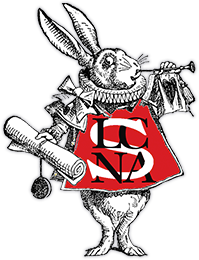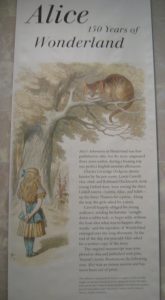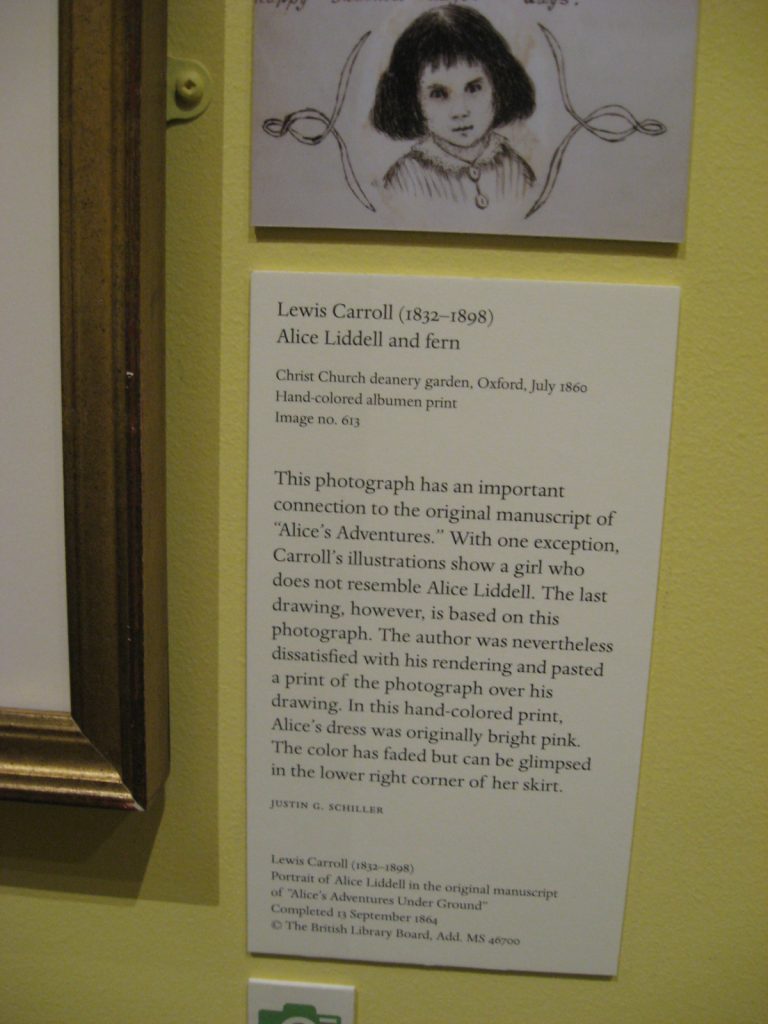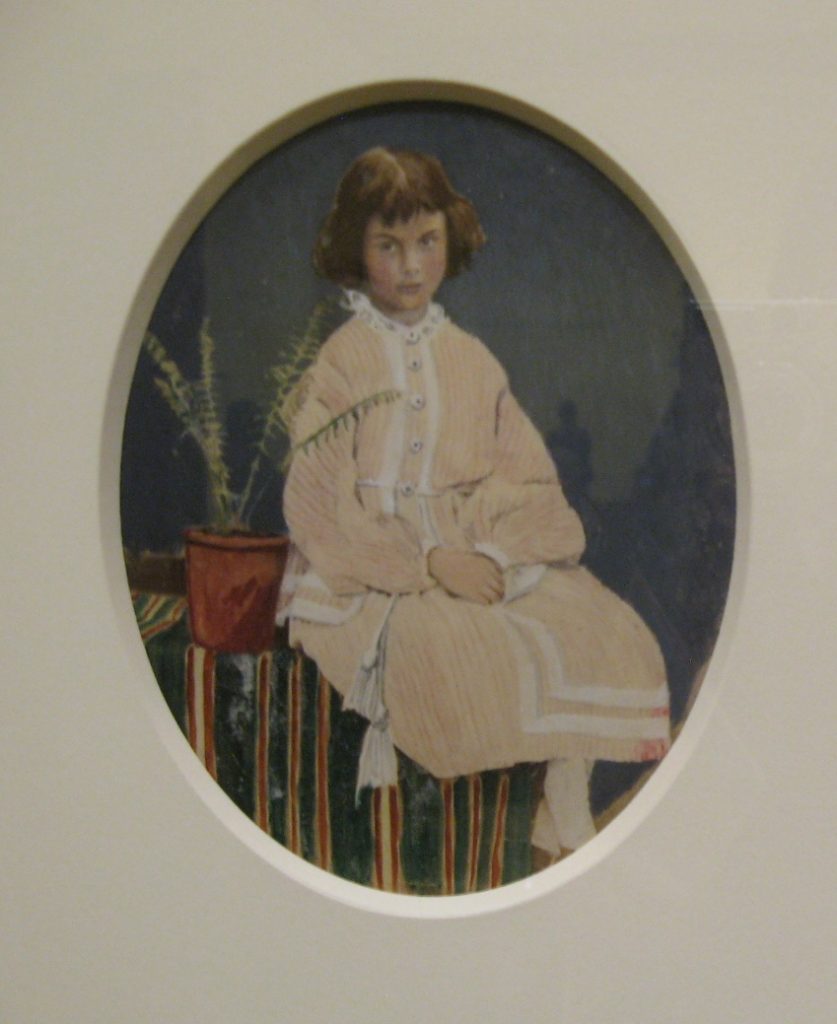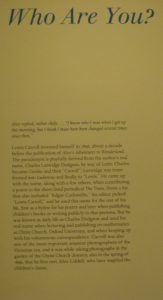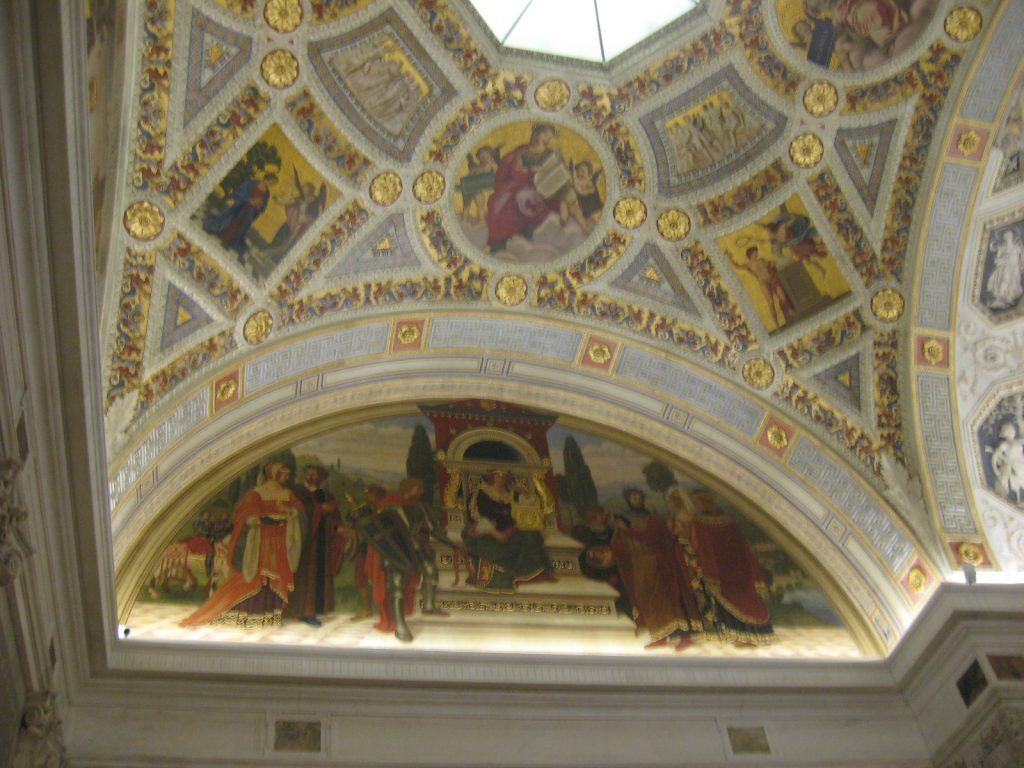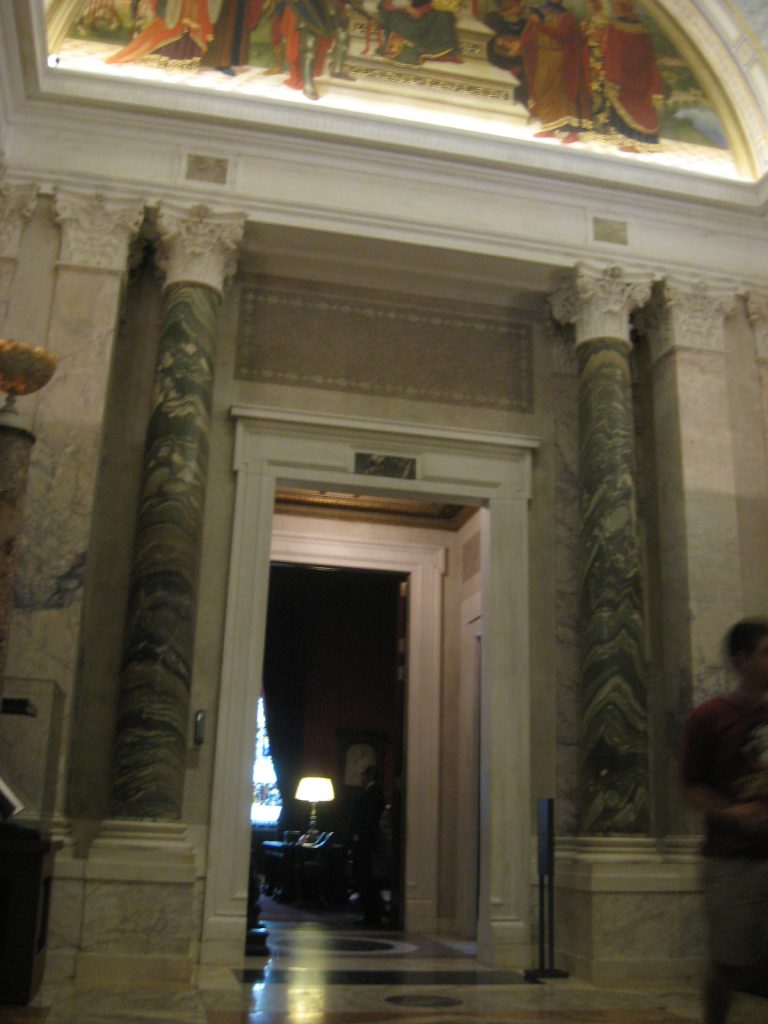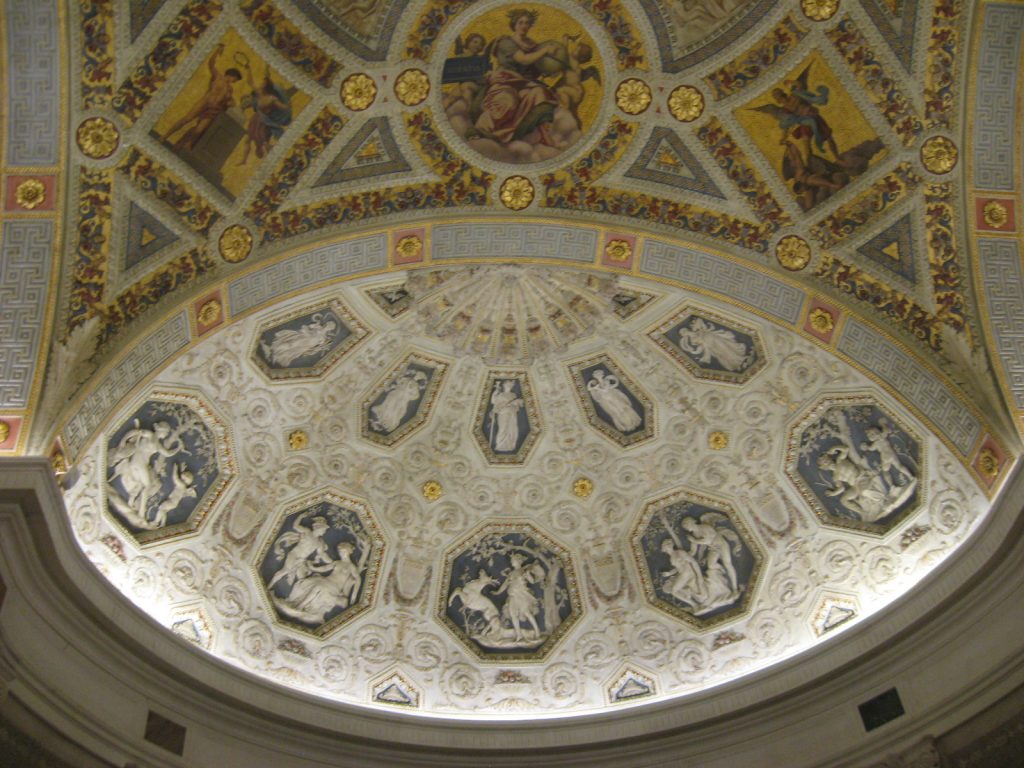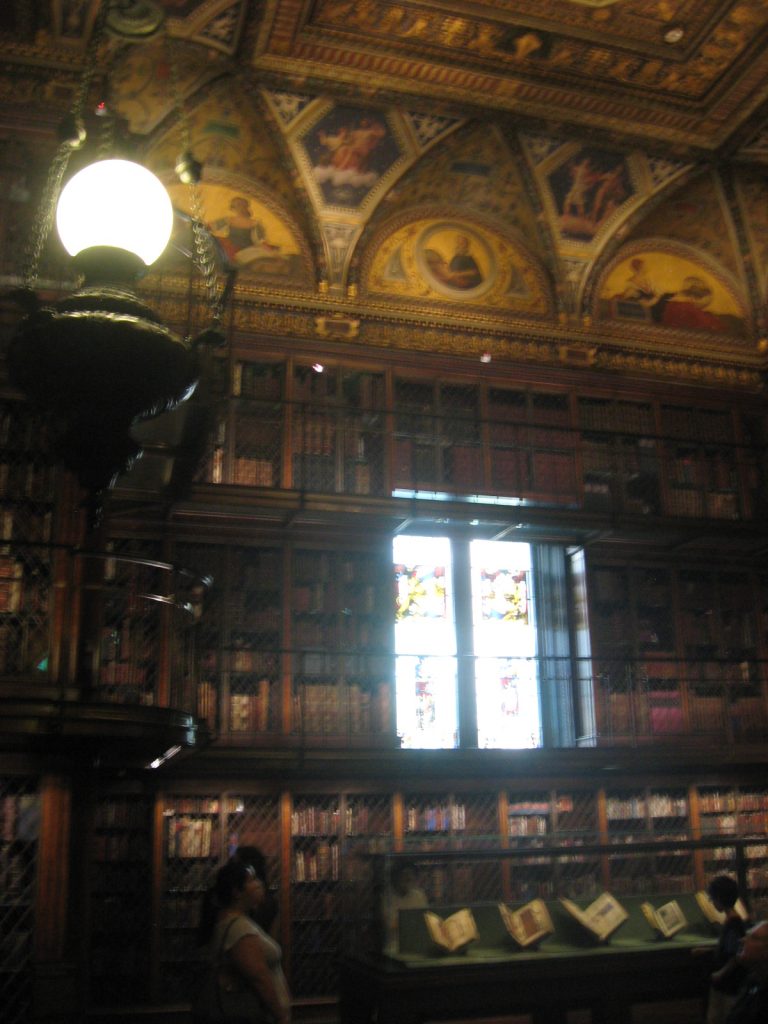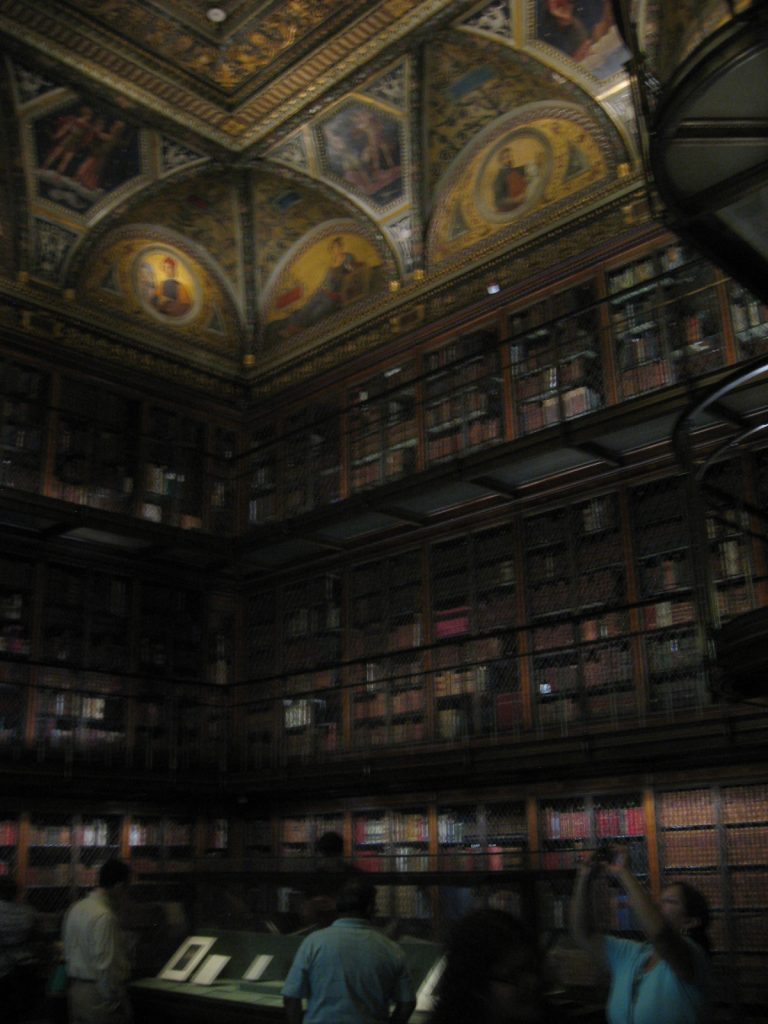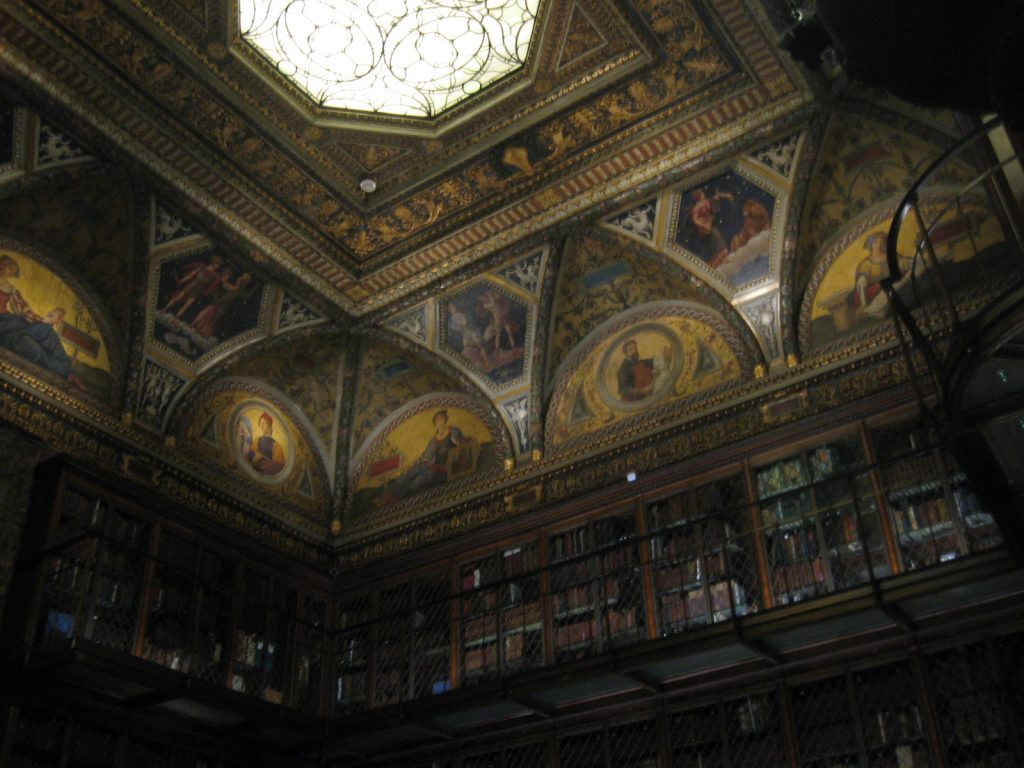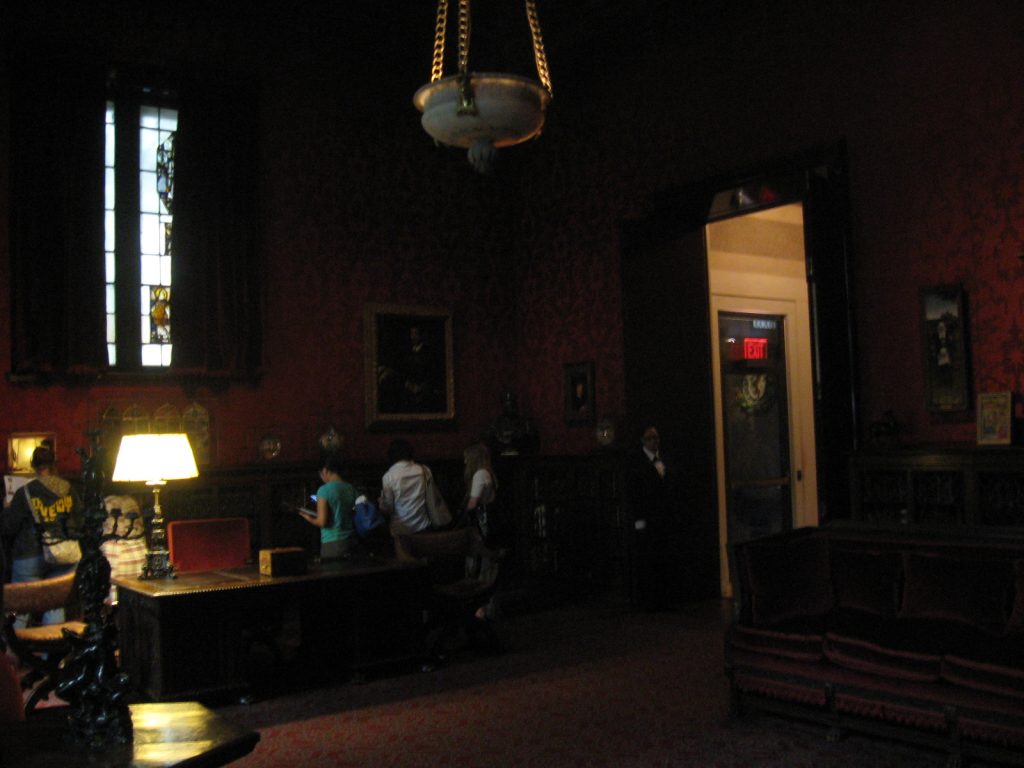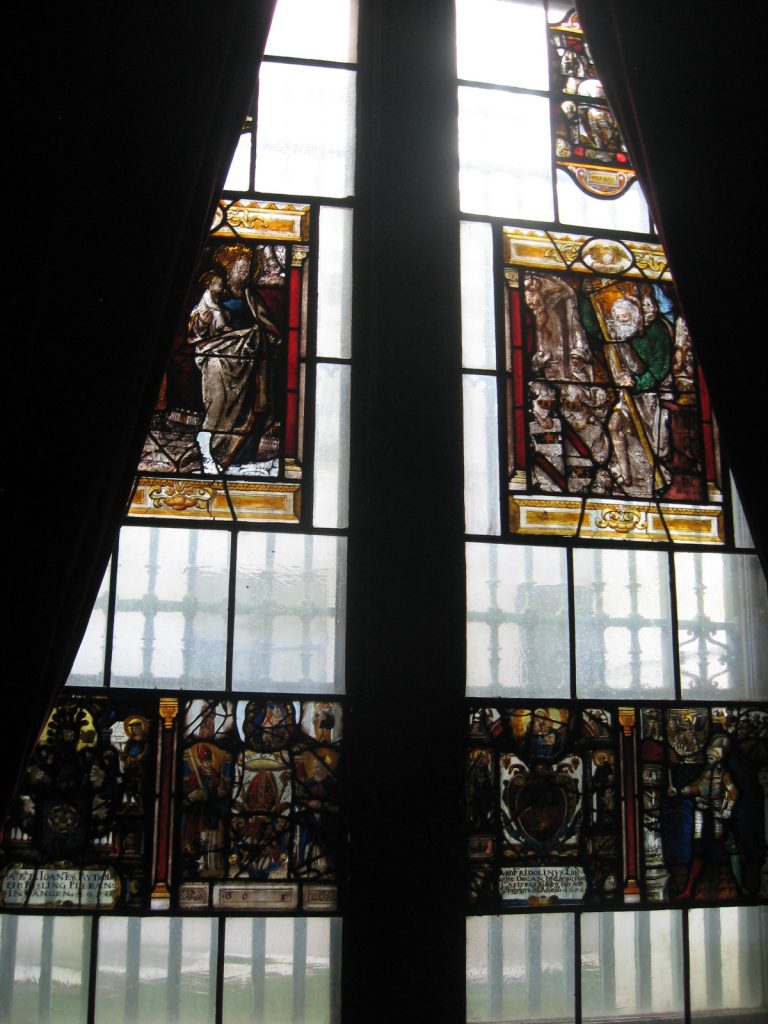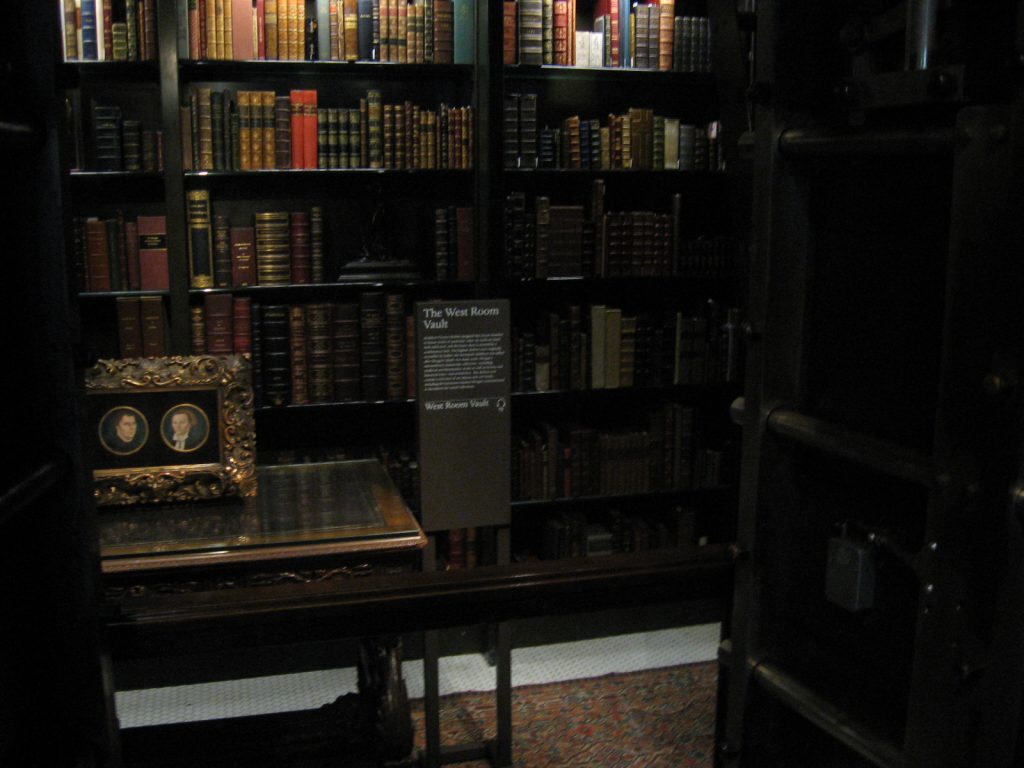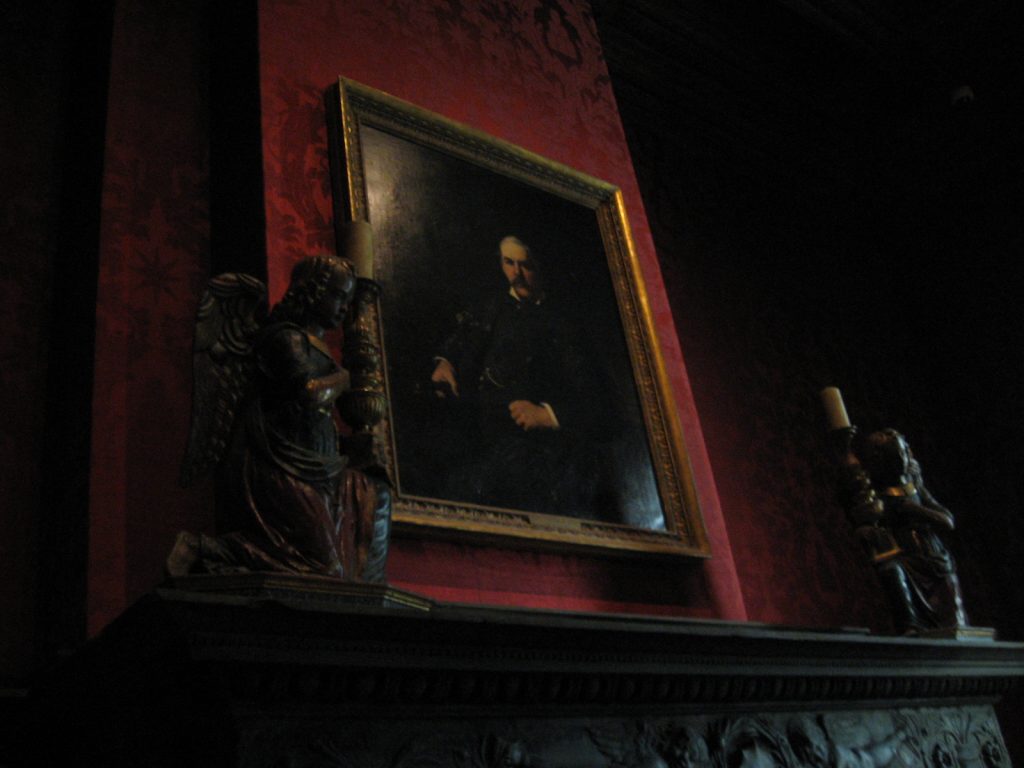The mind-blowingly informative Alice in a World of Wonderlands: The Translations of Lewis Carroll’s Masterpiece (Oak Knoll in cooperation with the LCSNA) is here! Read about the magnificent three-volume set (Essays, Back Translations, and Checklists), which discusses translations into 174 languages and dialects, on its website. Oak Knoll is offering a 10% discount to our members here. Our sincerest congratulations to general editor Jon Lindseth, technical editor Alan Tannenbaum, and the 260 writers and editors who contributed to this extraordinary scholarly yet readable work, a successor to Warren Weaver’s Alice in Many Tongues (1964). It will be celebrated at a two-day conference at Alice150 this October, and an exhibition at the Grolier Club in New York, September 16 – November 21, 2015. O frabjous day! Callooh! Callay!
The Blog of the LCSNA
Burbles
The Blog of the LCSNA
A Personal Guided Tour of the Morgan Exhibit by Danny Ashkenasi
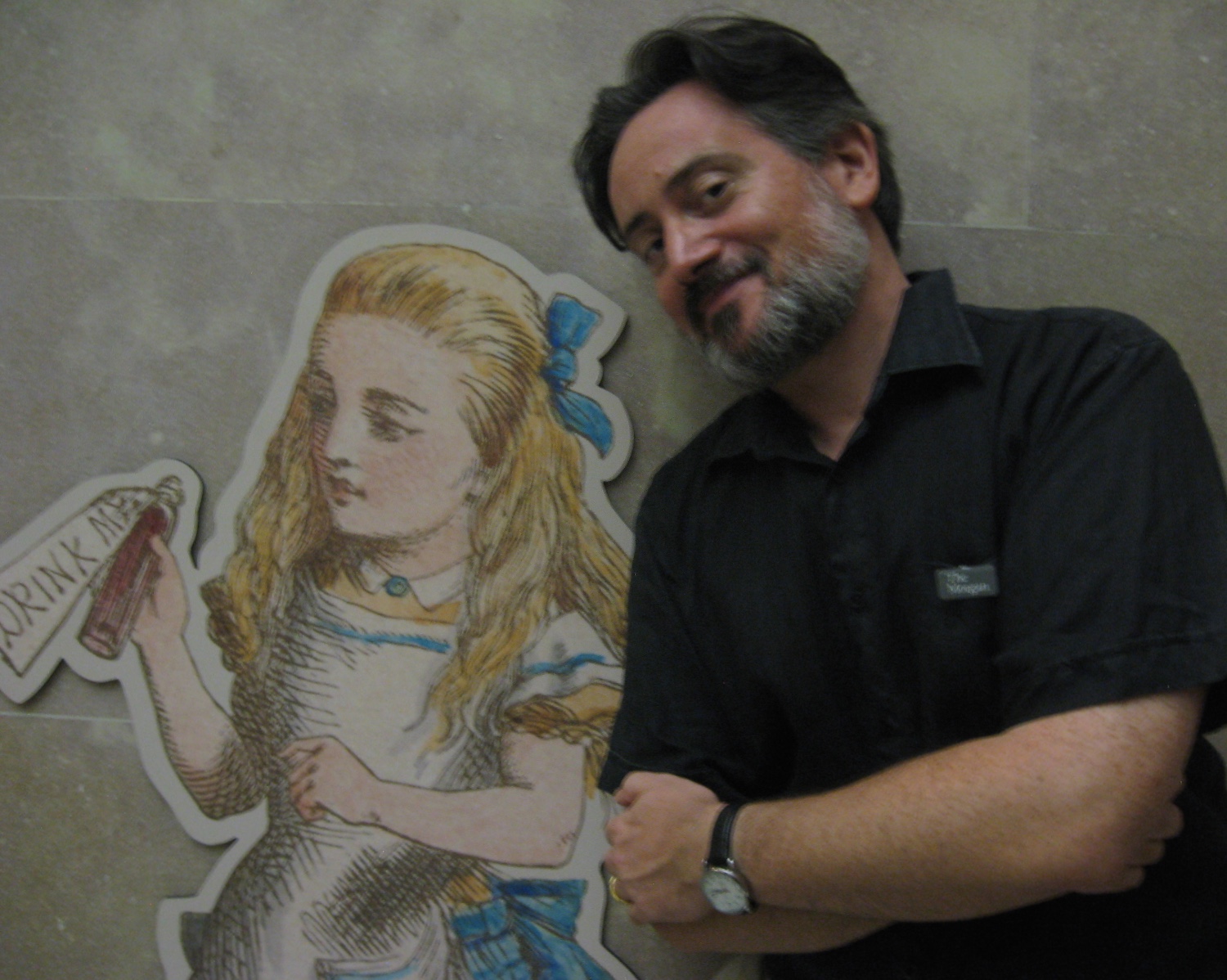
from Notes from a Composer
personal musings on music, theater and a life in the arts by Danny Ashkenasi
DANNY and KELLY go see ALICE at THE MORGAN
August 12, 2015
by Danny Ashkenasi
Yesterday my Speakeasy co-producer Kelly Aliano and I went to The Morgan museum to take in their Alice – 150 Years of Wonderland exhibit, and tour the ground floor of the magnate’s palatial home and library too. As Lewis Carroll’s Alice books are such a big part of my musical Speakeasy – the Adventures of John and Jane Allison in the Wonderland, it seemed very apropos to check out this exhibit and share some impressions on this blog. Photography was allowed but limited only to those items that are part of the Morgan collection and not on loan.
We joined a tour in progress. The volunteer guide regaled us with the story of how Carroll, who initially independently financed the publishing of his books, considered the first press run not up to his exacting standards. So a new edition was produced at great expense. The “spoiled” books were not scrapped, however, but were shipped out for sale in the US market. I guess what wasn’t good enough for home consumption was just fine for the uncouth Yankees.
The exhibit focuses heavily on John Tenniel’s original illustrations, which in the guide’s (and my humble) opinion are the standard against which all future illustrations are (usually unfavorably) measured. John Tenniel, who lived to be 94(!), drew only in pencil, so any ink or colored in version of his work would be a copy, not necessarily a forgery but often mistakenly attributed to Tenniel. For “Alice’s Adventures in Wonderland” Carroll meticulously pre-planned subject and lay-out of all illustrations, and drew many himself. He was unsatisfied with the quality of his own work, and thus turned to Tenniel. When Carroll hired Tenniel to illustrate the second Alice book “Through the Looking Glass”, Carroll had so much confidence in Tenniel’s work that he gave the artist free reign to choose and design the illustrations. Carroll even excised a chapter called “The Wasp in the Wig”, when Tenniel insisted it was not possible to illustrate such a thing.
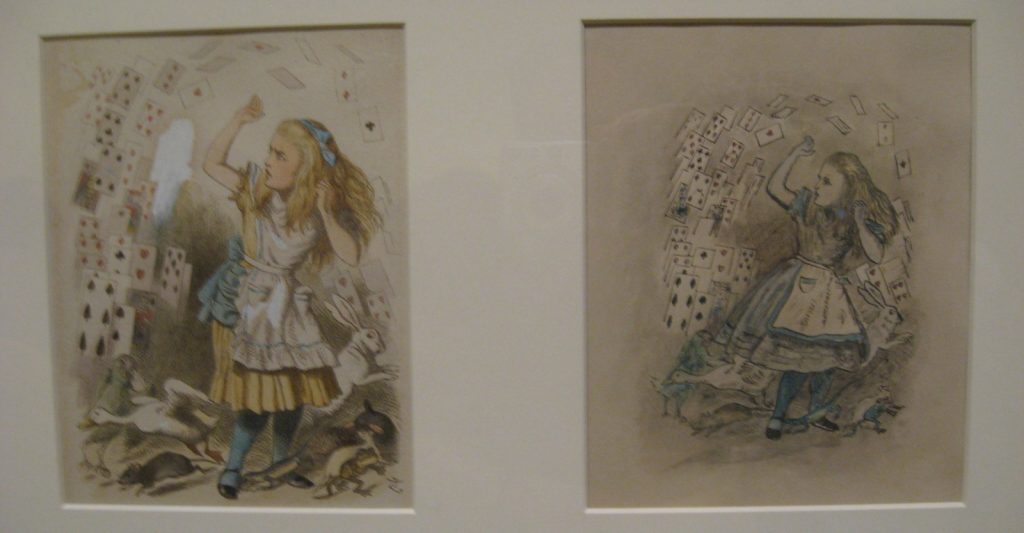
A highlight of the exhibit was the screening of a surviving print of a 1903 silent movie short of Alice in Wonderland. Very few movies of that era survive, so this is something special, especially considering that it shows that certain camera tricks and special effects were already in use so early in film making history (the screen picture in The Morgan is brighter than this YouTube embed. The shot where Alice “shrinks” or “grows” shows the background against which she is changing size more clearly, for example):
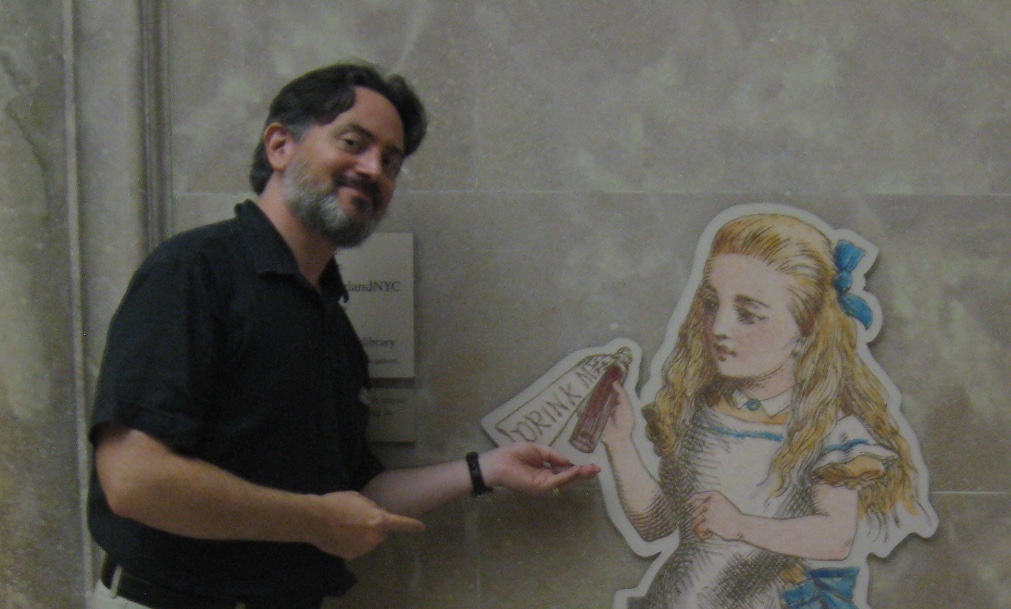
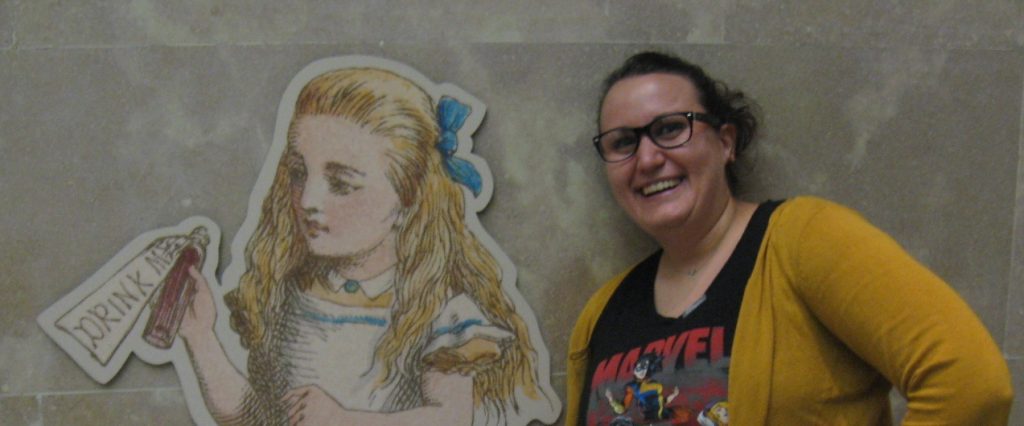
The Guide solicited readings from the attendees, which is how I was roped into reciting the Jabberwocky in full classical actor mode, after I had heedlessly mumbled out loud that it is a rather difficult poem to sight-read:
‘Twas brillig, and the slithy toves
Did gyre and gimble in the wabe:
All mimsy were the borogoves
And the mome raths outgrabe
….
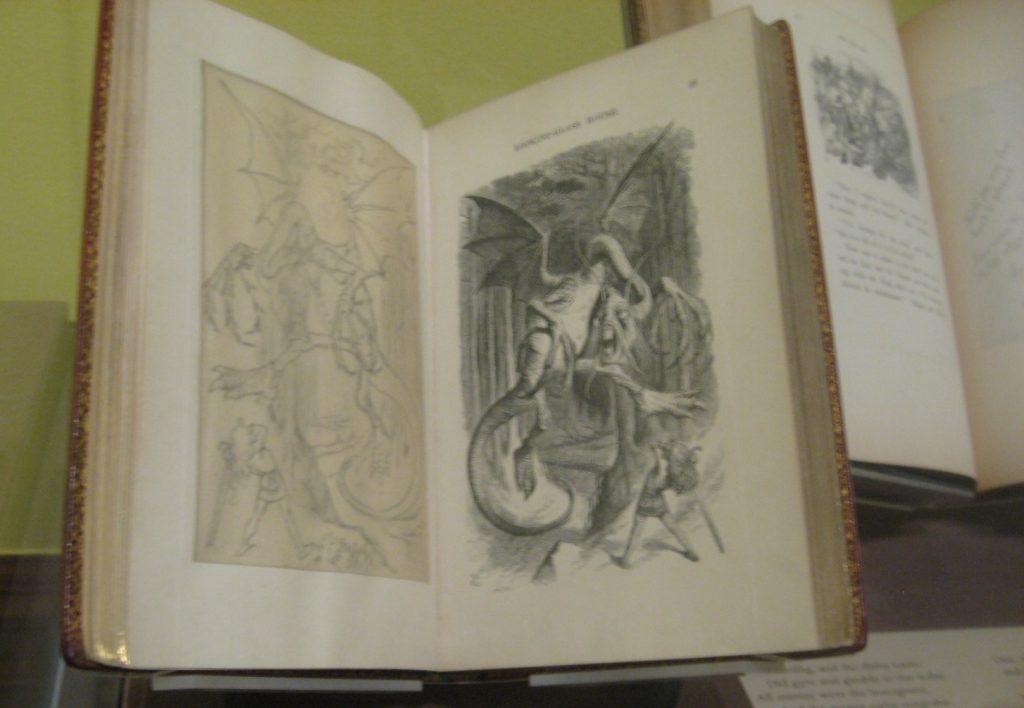
Luckily my classical training (cough cough) stood me in good stead and I managed a credible performance. The guide talked about how the poem has been translated into several languages. One attendee said that should be easy, since you wouldn’t have to translate the “nonsense” words but simply “copy them”. But I didn’t think it would be so easy, although I kept my thoughts to myself. The sounds of letters don’t translate directly from language to language, and even so don’t necessarily evoke the same feelings from language to language, so some thought would have to be put into effectively translating even a nonsense word. And a google search of the German version, called “Der Jammerwoch”, bears that out.
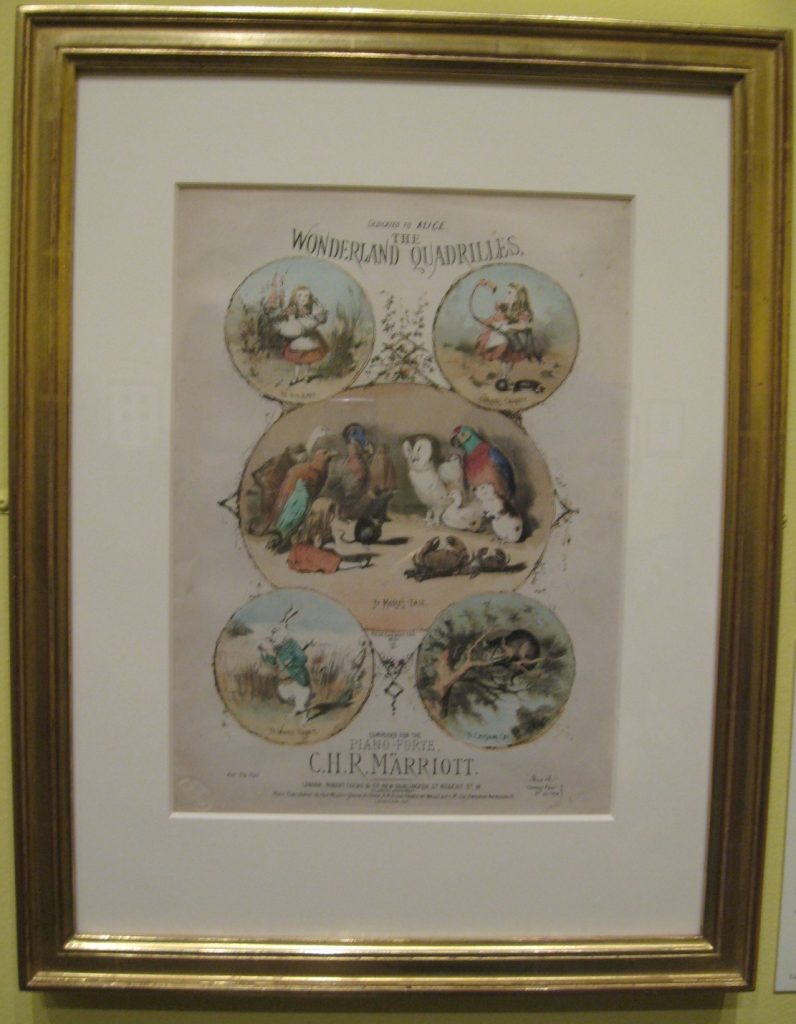
Identity, unfixed, mutable, confounding, its loss or the changing ways one is perceived by others and by oneself, is a big part of Carroll’s Alice books.
This theme is carried over into the musical “Speakeasy”.
Much like Alice in Wonderland and Through the Looking Glass, Speakeasy’s John and Jane Allison find themselves changing in subtle and alarming ways. Who and what they are is questioned and challenged repeatedly, by others and even themselves. John, like Alice, even literally forgets himself, falling into a kind of identity amnesia at one point.
The name Lewis Carroll itself is an identity that the author, born Charles Lutwidge Dodgson, created (see right).
There is so much more to see at the Morgan’s Alice exhibit, and so much more for me to say about Alice and Speakeasy. For now, look forward to more articles and enjoy the ones already posted.
And to close, below are some images from the main part of The Morgan: ground floor of J.P. Morgan’s wildly opulent home with its cathedral parlor, massive library, and the richly musty, dark study.
The Parlor:
The Library:
The Study:
Two Swell New Comic Reprints
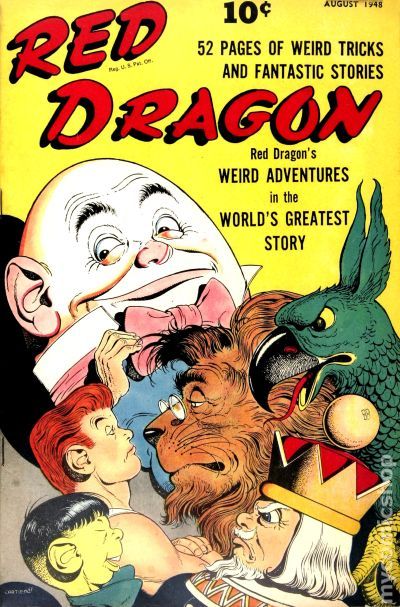 Red Dragon #4 (August 1948) is a comic so rare that it only rated a note (p. 71), not a listing, in the definitive Pictures and Conversations: Lewis Carroll in the Comics, as none of the authors had ever seen a copy, which sells for $200-$500 these days. Fortunately, we all can have a b&w reproduction of the story, along with an article about its creator, Edd Cartier, as they now appear in The Shadow , Volume 86, by Sanctum Books (2014), obtainable at Bud Plant for $15. Cartier also illustrated the story “Jabberwocky Thrust” in Shadow Mystery magazine (Oct. – Nov. 1947).
Red Dragon #4 (August 1948) is a comic so rare that it only rated a note (p. 71), not a listing, in the definitive Pictures and Conversations: Lewis Carroll in the Comics, as none of the authors had ever seen a copy, which sells for $200-$500 these days. Fortunately, we all can have a b&w reproduction of the story, along with an article about its creator, Edd Cartier, as they now appear in The Shadow , Volume 86, by Sanctum Books (2014), obtainable at Bud Plant for $15. Cartier also illustrated the story “Jabberwocky Thrust” in Shadow Mystery magazine (Oct. – Nov. 1947).
The wonderfully printed and thrillingly oversized (21.6 x 16.9 inches; 55 x 43 cm.) Society is Nix: Gleeful Anarchy of the Dawn of the American Comic Strip 1895-1915 ($125 list) reproduces both the teaser page for the first instance of Alice in the “funny pages” (“Alice’s Adventures in Funnyland,” Chicago Sunday Tribune, November 10, 1901 — yes, the “Alfred E. Neuman” lookalike) and a page from Buddy Tucker Meets Alice in Wonderland (1906). (The “Funnyland” page and a similar page from Buddy Tucker are in Alice in Comicland [$30 list] although at a smaller size.) The rest of the book is wonderful as well; Chris Ware calls it, “a mind-blowing portable museum retrospective of the raw, tangled ferocity and frustration that went into the making of America.”
Charon-dipity?
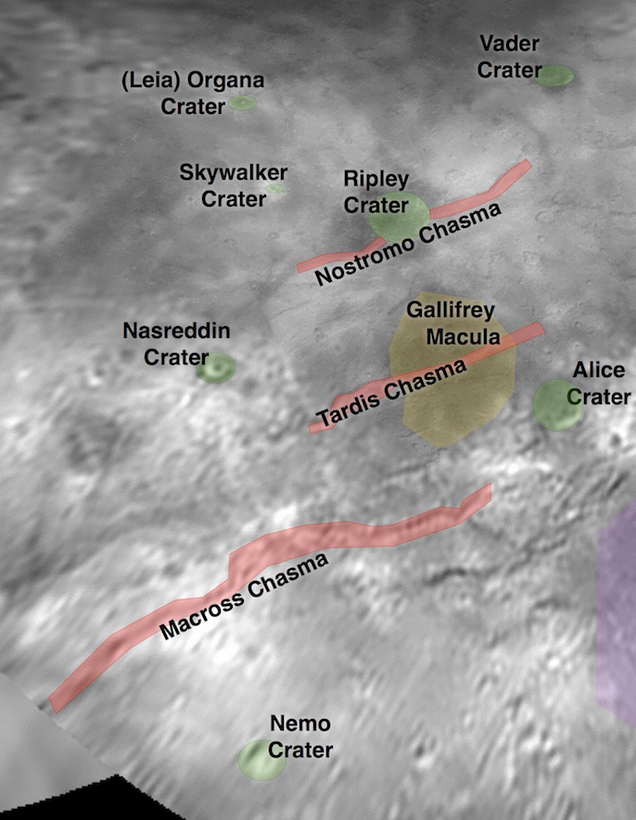 New Horizons, NASA’s mission to Pluto, has been “geeking out” labeling all interesting features on the dwarf planet Pluto and its supersized moon Charon with unofficial names, many of which were submitted to the IAU (International Astronomical Union), as they are currently meeting in Honolulu and who can make them official. Not surprisingly, many geek idols from Dr. Who to our own Alice (in the Western Region of Charon, on the right of the image at left) have been proposed. Click here for a fun article on the subject!
New Horizons, NASA’s mission to Pluto, has been “geeking out” labeling all interesting features on the dwarf planet Pluto and its supersized moon Charon with unofficial names, many of which were submitted to the IAU (International Astronomical Union), as they are currently meeting in Honolulu and who can make them official. Not surprisingly, many geek idols from Dr. Who to our own Alice (in the Western Region of Charon, on the right of the image at left) have been proposed. Click here for a fun article on the subject!
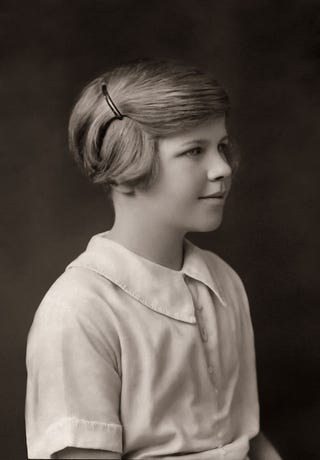 Always a local angle. When the (now dwarf) planet was discovered by Clyde Tombaugh, Venetia Burney (1918-2009, right), who was then 11, suggested the name “Pluto” to her grandfather Falconer Madan, who passed the name along to Herbert Hall Turner, an astronomer with the Royal Astronomical Society. Clyde Tombaugh liked the name because it started with the initials of Percival Lowell, who had predicted the existence of Planet X.
Always a local angle. When the (now dwarf) planet was discovered by Clyde Tombaugh, Venetia Burney (1918-2009, right), who was then 11, suggested the name “Pluto” to her grandfather Falconer Madan, who passed the name along to Herbert Hall Turner, an astronomer with the Royal Astronomical Society. Clyde Tombaugh liked the name because it started with the initials of Percival Lowell, who had predicted the existence of Planet X.
Falconer Madan of Oxford, Librarian of the Bodleian among many other titles, was, of course, a devoted Carrollian. He helped Sidney Herbert Williams revise his A Bibliography of Lewis Carroll (London: The Bookman’s Journal, 1924), the first such, into A Handbook of the Literature of the Rev. C. L. Dodgson (Lewis Carroll) (London: Oxford University Press, 1931), receiving co-author credit, and published a supplement thereto in 1935.
We do hope the name “Alice Crater” will be duly authorized. “Twinkle, twinkle…”
Alice’s Right Foot, Esq.
How can one resist? Well, it only comes in smaller adult sizes, for one. Its full name is “Vans Authentic Liberty Wonderland Skate Shoe.” You may have to look around online or visit your local Vans dealer; Amazon lists it here.
Adriana Peliano’s Illustrated Wonderland and Looking-Glass
 As many of us know, in addition to being the founder of the Sociedade Lewis Carroll do Brasil, Adriana Peliano is a genuinely talented artist. Her dreamy, “alicedelic” illustrations are collages based on colored Tenniels and the work of other creatives, often made kaleidoscopic, and full of puzzles and paradoxes. The two books are combined and have just been published in a handsome, colorful, luminous volume by Zahar in Brazil (the text is in Portuguese, of course).
As many of us know, in addition to being the founder of the Sociedade Lewis Carroll do Brasil, Adriana Peliano is a genuinely talented artist. Her dreamy, “alicedelic” illustrations are collages based on colored Tenniels and the work of other creatives, often made kaleidoscopic, and full of puzzles and paradoxes. The two books are combined and have just been published in a handsome, colorful, luminous volume by Zahar in Brazil (the text is in Portuguese, of course).
The easiest thing to do is to order it by emailing Adriana. The book is US$29 and postage to the U.S. is about $11. She can do it through PayPal.*
Most highly recommended!
P.S. Yes, the cover just says Wonderland; if you flip the book over, Looking-glass is the back cover.
* Or you can order from the Livraria Cultura bookshop or the publisher, Zahar, if your Portuguese is up to it. Costs are roughly the same.
New Sharing Buttons Have Arrived on the Blog

Lavish Wonderland with 150 Illustrators!
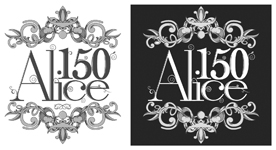 An extraordinary edition of Wonderland is being published as a 150th Anniversary treat. Each page is illustrated by a different artist from around the globe! (There will be 150 pages, not so coincidentally.) The project, which benefits art instruction for Mongolian and Chinese children, is funded through Indegogo. Watch an introductory video here. The book will be released in December at a $99 price; the first 150 are $60, after that it will be $70, so haste is encouraged. The art is most impressive, and it’s for a very good cause. Click here!
An extraordinary edition of Wonderland is being published as a 150th Anniversary treat. Each page is illustrated by a different artist from around the globe! (There will be 150 pages, not so coincidentally.) The project, which benefits art instruction for Mongolian and Chinese children, is funded through Indegogo. Watch an introductory video here. The book will be released in December at a $99 price; the first 150 are $60, after that it will be $70, so haste is encouraged. The art is most impressive, and it’s for a very good cause. Click here!
A Little Light Marine Biology Reading for you Cheshire Cat Fans…
So did you know that biologists use characters from Carroll to describe biological phenomena? I didn’t. The Red Queen has been in use for some time, but now the Cheshire Cat has his turn, describing a phenomenon whereby a particular species of marine life ‘escapes’ from a hazardous environment – in this case one with a virus. If you understand it all, please enlighten me 😉 From the Proceedings of the National Academy of Sciences.
…These “Cheshire Cat” ecological dynamics release host evolution from pathogen pressure and thus can be seen as an opposite force to a classic “Red Queen” coevolutionary arms race. In E. huxleyi, this phenomenon can account for the fact that the selective balance is tilted toward the boom-and-bust scenario of optimization of both growth rates of calcifying E. huxleyi cells and infectivity of EhVs
Communicated by Paul G. Falkowski, Rutgers, The State University of New Jersey, New Brunswick, NJ, August 6, 2008 (received for review June 9, 2008)
“Pamphlets Vol. 5: Games, Puzzles, and Related Pieces” Released!
We are very proud to announce volume five in our projected six-part series The Pamphlets of Lewis Carroll, whose goal has been to publish all of Carroll’s many pamphlets in uniform book editions by topic. Edited by Christopher Morgan, this volume gathers together and annotates all editions of Carroll’s game and puzzle pamphlets for the first time, and features the first publication in book form of Carroll’s little-known magazine columns devoted to his word games Doublets and Syzygies, which appeared in the British magazines Vanity Fair and The Lady and contain many fresh examples of Carroll’s wit. Also included are many previously unpublished letters from Carroll to friends and colleagues dealing with his puzzles and games.
Besides Doublets and Syzygies, the book also features Carroll’s board game Lanrick, Circular Billiards, Castle Croquet, a previously unknown Carroll puzzle called “String Wrapped Round a Cube,” Backgammon variations, Mirror Writing, Arithmetical Croquet, a Number Guessing Puzzle, and many others. There are also chapters on the legacy of Carroll’s puzzles, magic tricks he liked to perform, and modern-day puzzles inspired by his inventions.
Order from the University of Virginia Press here.
